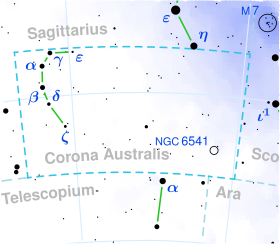Astronomy:Theta Coronae Australis
| Observation data Epoch J2000.0 Equinox (celestial coordinates) | |
|---|---|
| Constellation | Corona Australis |
| Right ascension | 18h 33m 30.18577s[1] |
| Declination | −42° 18′ 45.0297″[1] |
| Apparent magnitude (V) | 4.61±0.01[2] |
| Characteristics | |
| Spectral type | G8 III[3] |
| U−B color index | +0.76[4] |
| B−V color index | +1.02[4] |
| Astrometry | |
| Radial velocity (Rv) | −2.1±2.8[5] km/s |
| Proper motion (μ) | RA: +32.046[1] mas/yr Dec.: −20.932[1] mas/yr |
| Parallax (π) | 6.1673 ± 0.1535 mas |
| Distance | 530 ± 10 ly (162 ± 4 pc) |
| Absolute magnitude (MV) | −1.54[6] |
| Details | |
| Mass | 4.45±0.22[7] M☉ |
| Radius | 29.1±1.5[8] R☉ |
| Luminosity | 411+21−19[1] L☉ |
| Surface gravity (log g) | 2.50[9] cgs |
| Temperature | 4,907±59[10] K |
| Metallicity [Fe/H] | +0.00[1] dex |
| Rotational velocity (v sin i) | 12±1[11] km/s |
| Other designations | |
| Database references | |
| SIMBAD | data |
Theta Coronae Australis (Theta CrA), Latinized from θ Coronae Australis, is a solitary yellow-hued star[13] located in the southernconstellation Corona Australis. It has an apparent magnitude of 4.61, making it readily visible to the naked eye. Gaia DR3 parallax measurements place it 530 light years away and it is currently drifting closer with a somewhat constrained heliocentric radial velocity of −2.1 km/s. At its current distance, Theta CrA's brightness is diminished by three-tenths of a magnitudes due to interstellar dust.[14] It has an absolute magnitude of −1.54.[6]
This is an evolved red giant with a stellar classification of G8 III.[3] It has 4.45 times the mass of the Sun[7] but has expanded to 29.1 times the solar radius.[8] It radiates 411 times the luminosity of the Sun[1] from its enlarged photosphere at an effective temperature of 4,907 K.[10] Theta CrA has a solar metallicity;[1] unlike most giant stars of this type, Theta CrA has an unusually high rate of rotation with a projected rotational velocity of 12 km/s.[11] The star may also have infrared excess, suggesting the presence of a circumstellar disk.[15] One possible explanation is that it may have engulfed a nearby giant planet, such as a hot Jupiter.[15]
References
- ↑ 1.0 1.1 1.2 1.3 1.4 1.5 1.6 Vallenari, A. et al. (2022). "Gaia Data Release 3. Summary of the content and survey properties". Astronomy & Astrophysics. doi:10.1051/0004-6361/202243940 Gaia DR3 record for this source at VizieR.
- ↑ Høg, E.; Fabricius, C.; Makarov, V. V.; Urban, S.; Corbin, T.; Wycoff, G.; Bastian, U.; Schwekendiek, P. et al. (March 2000). "The Tycho-2 catalogue of the 2.5 million brightest stars". Astronomy and Astrophysics 355: L27–L30. ISSN 0004-6361. Bibcode: 2000A&A...355L..27H.
- ↑ 3.0 3.1 Houk, Nancy (1978). Michigan catalogue of two-dimensional spectral types for the HD stars Volume II: Declinations −53° to −40°. Bibcode: 1978mcts.book.....H.
- ↑ 4.0 4.1 Johnson, H. L.; Mitchell, R. I.; Iriarte, B.; Wisniewski, W. Z. (1966). "UBVRIJKL Photometry of the Bright Stars". Communications of the Lunar and Planetary Laboratory 4: 99–110. Bibcode: 1966CoLPL...4...99J.
- ↑ Gontcharov, G. A. (November 2006). "Pulkovo Compilation of Radial Velocities for 35,495 Hipparcos stars in a common system". Astronomy Letters 32 (11): 759–771. doi:10.1134/S1063773706110065. ISSN 1063-7737. Bibcode: 2006AstL...32..759G.
- ↑ 6.0 6.1 Anderson, E.; Francis, Ch. (May 2012). "XHIP: An extended hipparcos compilation". Astronomy Letters 38 (5): 331–346. doi:10.1134/S1063773712050015. ISSN 1063-7737. Bibcode: 2012AstL...38..331A.
- ↑ 7.0 7.1 Kervella, Pierre; Arenou, Frédéric; Thévenin, Frédéric (20 December 2021). "Stellar and substellar companions from Gaia EDR3". Astronomy & Astrophysics 657: A7. doi:10.1051/0004-6361/202142146. ISSN 0004-6361. Bibcode: 2022A&A...657A...7K.
- ↑ 8.0 8.1 Kervella, P.; Thévenin, F.; Di Folco, E.; Ségransan, D. (October 2004). "The angular sizes of dwarf stars and subgiants". Astronomy & Astrophysics 426 (1): 297–307. doi:10.1051/0004-6361:20035930. ISSN 0004-6361. Bibcode: 2004A&A...426..297K.
- ↑ Lafrasse, Sylvain; Mella, Guillaume; Bonneau, Daniel; Duvert, Gilles; Delfosse, Xavier; Chesneau, Olivier; Chelli, Alain (16 July 2010). "Building the 'JMMC Stellar Diameters Catalog' using SearchCal". Optical and Infrared Interferometry II. 7734. pp. 77344E. doi:10.1117/12.857024. Bibcode: 2010SPIE.7734E..4EL.
- ↑ 10.0 10.1 Blackwell, D. E.; Lynas-Gray, A. E. (May 1998). "Determination of the temperatures of selected ISO flux calibration stars using the Infrared Flux Method". Astronomy and Astrophysics Supplement Series 129 (3): 505–515. doi:10.1051/aas:1998202. ISSN 0365-0138. Bibcode: 1998A&AS..129..505B.
- ↑ 11.0 11.1 De Medeiros, J. R.; Alves, S.; Udry, S.; Andersen, J.; Nordström, B.; Mayor, M. (January 2014). "A catalog of rotational and radial velocities for evolved stars V: Southern stars". Astronomy & Astrophysics 561: A126. doi:10.1051/0004-6361/201220762. ISSN 0004-6361. Bibcode: 2014A&A...561A.126D.
- ↑ "* tet CrA". SIMBAD. Centre de données astronomiques de Strasbourg. http://simbad.u-strasbg.fr/simbad/sim-basic?Ident=%2A+tet+CrA.
- ↑ Eggleton, P. P.; Tokovinin, A. A. (11 September 2008). "A catalogue of multiplicity among bright stellar systems". Monthly Notices of the Royal Astronomical Society 389 (2): 869–879. doi:10.1111/j.1365-2966.2008.13596.x. ISSN 0035-8711. Bibcode: 2008MNRAS.389..869E.
- ↑ Gontcharov, George A.; Mosenkov, Aleksandr V. (28 September 2017). "Verifying reddening and extinction for Gaia DR1 TGAS main sequence stars". Monthly Notices of the Royal Astronomical Society 472 (4): 3805–3820. doi:10.1093/mnras/stx2219. ISSN 0035-8711. Bibcode: 2017MNRAS.472.3805G.
- ↑ 15.0 15.1 da Silva, R. Rodrigues; Canto Martins, B. L.; De Medeiros, J. R. (4 March 2015). "On the Nature of Rapidly Rotating Single Evolved Stars". The Astrophysical Journal 801 (1): 54. doi:10.1088/0004-637X/801/1/54. Bibcode: 2015ApJ...801...54R.
<ref> tag with name "Gould1879" defined in <references> is not used in prior text.
 |


